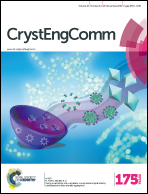Molecular tectonics: tetracarboxythiacalix[4]arene derivatives as tectons for the formation of hydrogen-bonded networks†
Abstract
A series of thiacalix[4]arene derivatives blocked in the 1,3-alternate conformation and bearing four carboxylic acids have been designed and synthesized. These compounds, owing to the H-bond donor (OH moiety) and acceptor (C![[double bond, length as m-dash]](https://www.rsc.org/images/entities/char_e001.gif) O group) nature of the carboxylic acid moieties, behave as self-complementary tectons and lead to the formation of tubular 1D H-bonded networks in the crystalline phase. Upon deprotonation of the self-complementary neutral compounds, i.e. transformation of carboxylic acid moieties into carboxylates, anionic tectons are generated. Due to their propensity to form H-bonded networks in the presence of a dicationic H-bond donor tecton of the cyclic bis-amidinium type, designed to behave as a molecular staple interconnecting two carboxylates moieties, 1- and 2-D H-bonded networks are formed under self-assembly conditions.
O group) nature of the carboxylic acid moieties, behave as self-complementary tectons and lead to the formation of tubular 1D H-bonded networks in the crystalline phase. Upon deprotonation of the self-complementary neutral compounds, i.e. transformation of carboxylic acid moieties into carboxylates, anionic tectons are generated. Due to their propensity to form H-bonded networks in the presence of a dicationic H-bond donor tecton of the cyclic bis-amidinium type, designed to behave as a molecular staple interconnecting two carboxylates moieties, 1- and 2-D H-bonded networks are formed under self-assembly conditions.
![Graphical abstract: Molecular tectonics: tetracarboxythiacalix[4]arene derivatives as tectons for the formation of hydrogen-bonded networks](/en/Image/Get?imageInfo.ImageType=GA&imageInfo.ImageIdentifier.ManuscriptID=C6CE02026G&imageInfo.ImageIdentifier.Year=2016)


 Please wait while we load your content...
Please wait while we load your content...